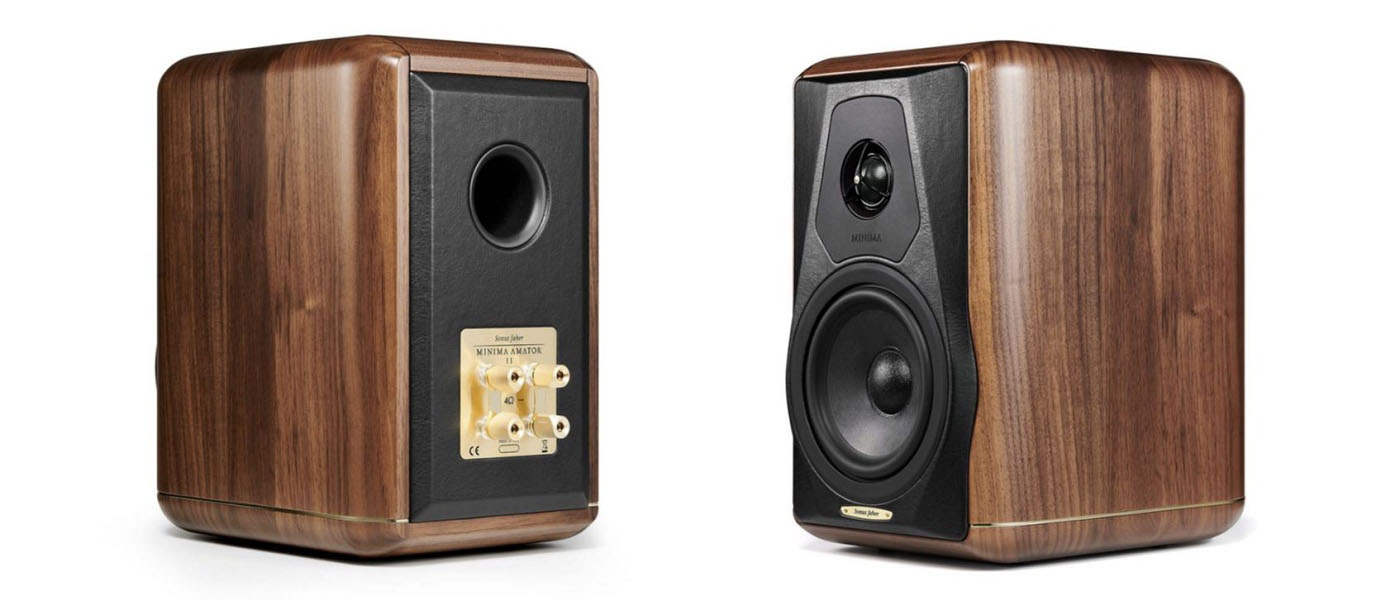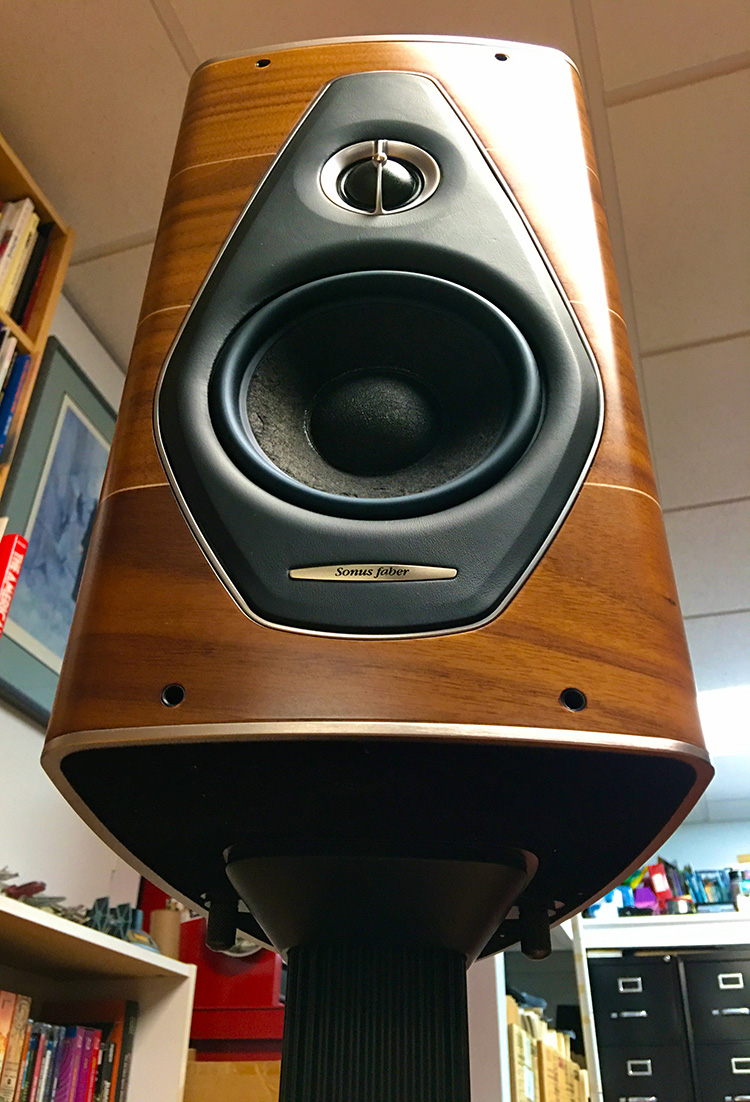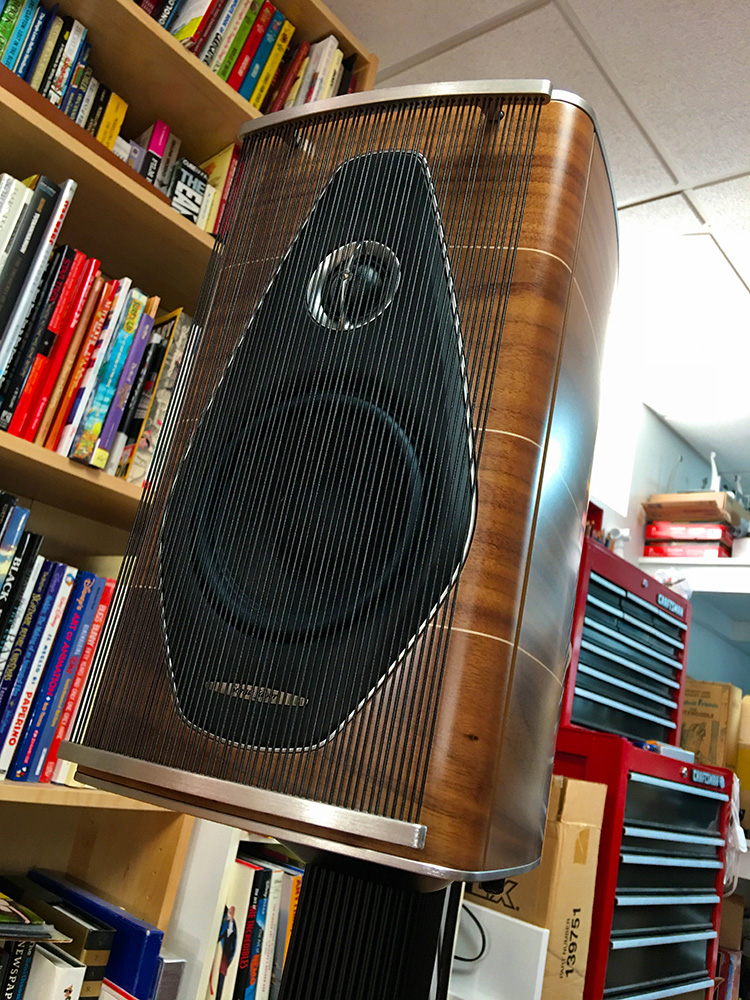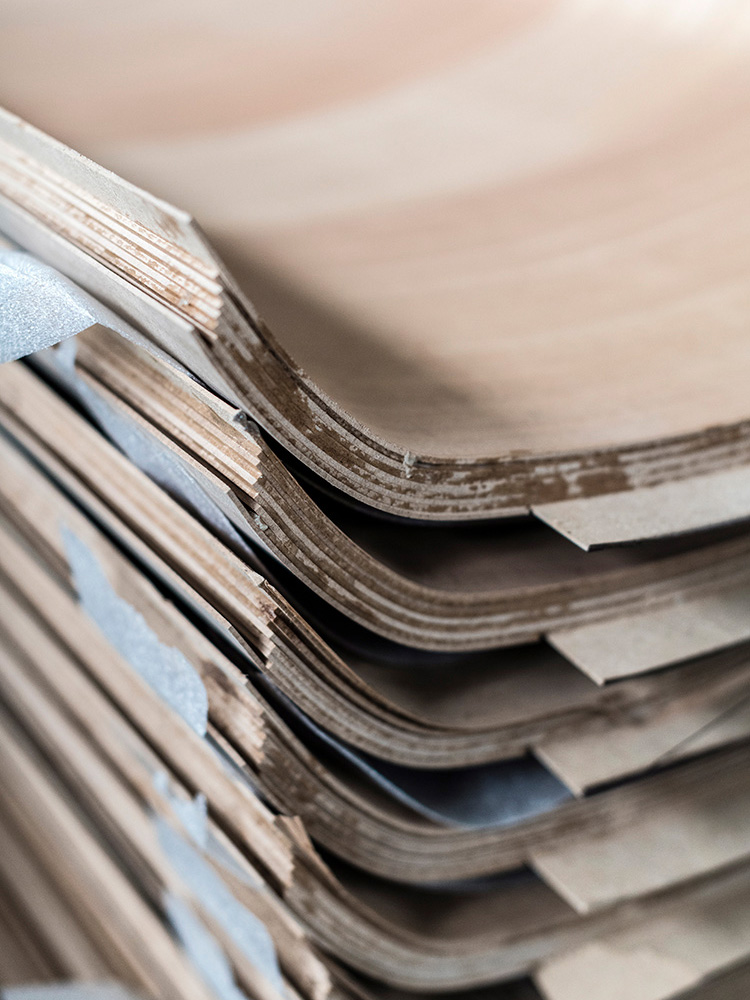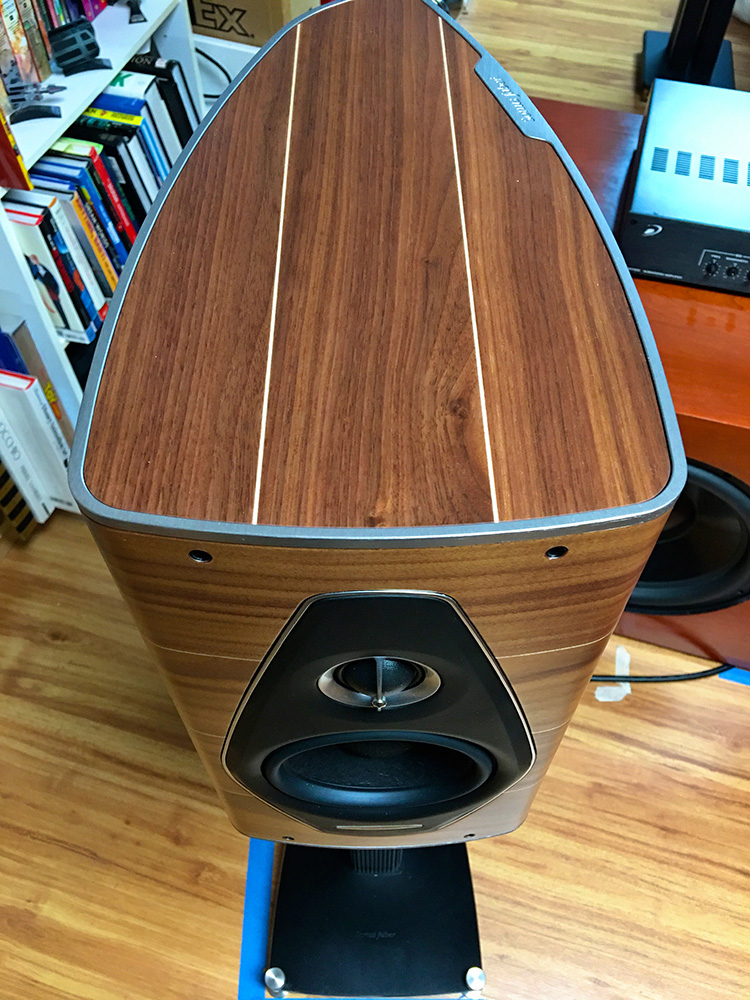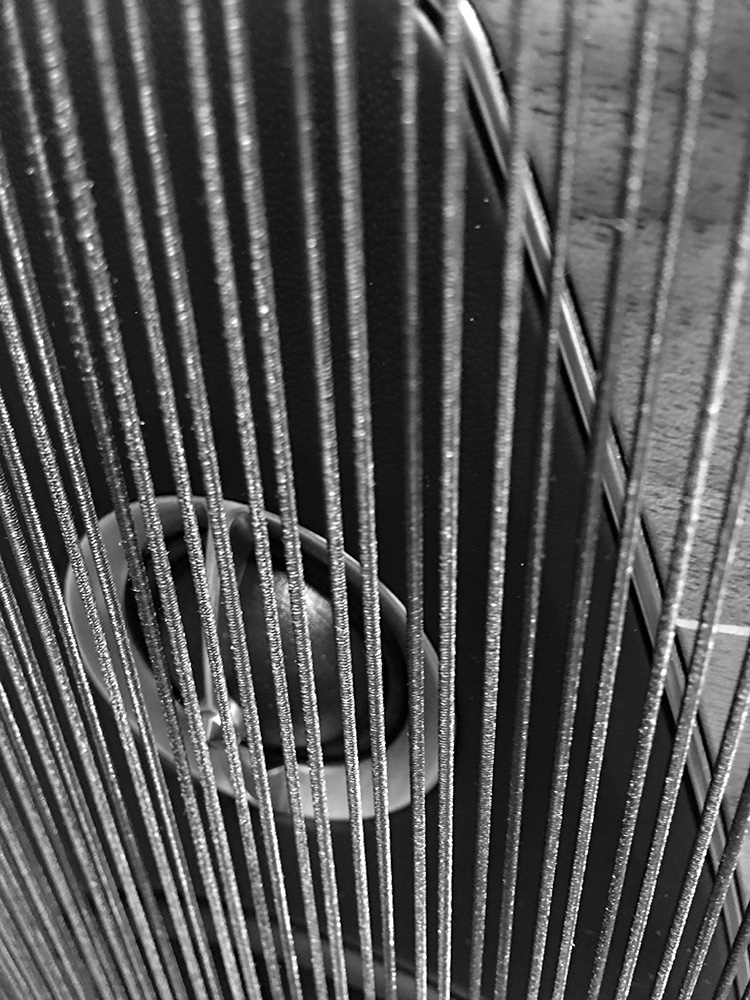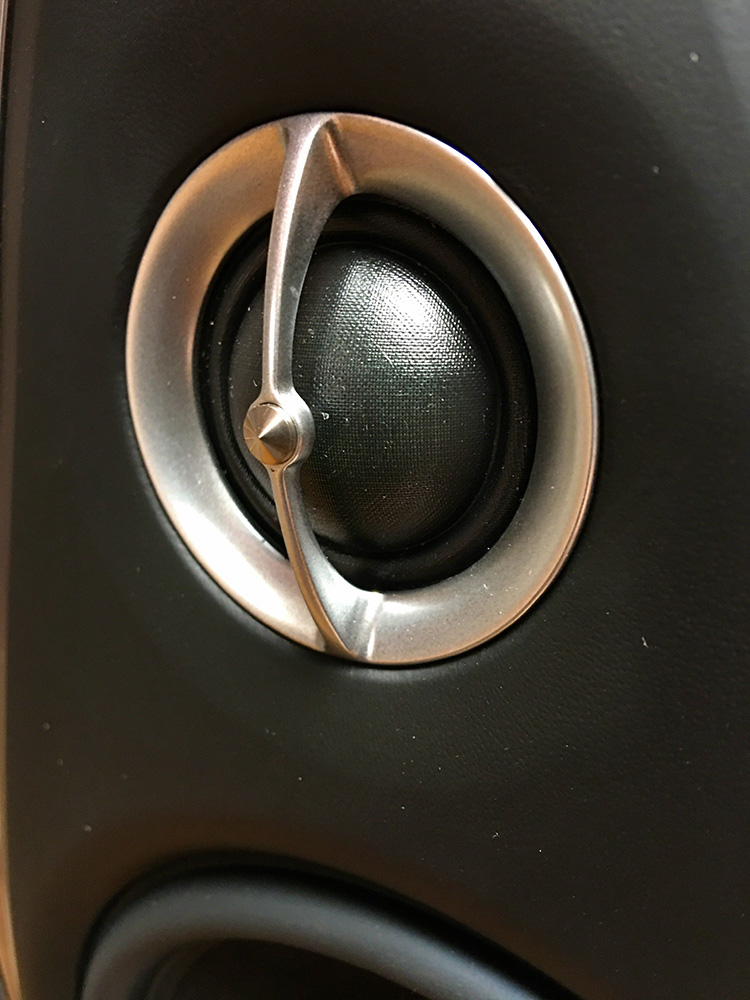This speaker is the smallest in the new Olympica Nova line that Sonus faber unveiled at this past RMAF. And while it may be considered the “baby” of the group, it certainly appears to have been lavished with the same care and attention to detail as its larger siblings. It is most assuredly one of the prettiest loudspeakers that I have ever come across and I confess to finding it’s sound quality equally beguiling. Forgive my rusty Italian but “Che Bellezza!”
Sonus faber Olympica Nova I Loudspeaker
- Beautiful aesthetics in the finest Italian tradition.
- Outstanding fit and finish.
- Sound quality is rich, tactile and very alive.
- They throw a big soundstage. Off-axis listening was very enjoyable.
- Great quality bass from this class of speaker. It packed a punch.

Ah, Italy – such a beautiful country! This fact I can personally attest to, having been fortunate enough to visit on a few occasions. It is also where my family hails from – Sicily in particular. But beyond the personal connection and affection that I feel for the place, it is a country with a history and traditions deeply steeped in the creative arts. And that creativity and passion are a keystone for so much of the Italian culture itself. From the amazing artistic and scientific advancements of the Renascence including the foundations of what we consider classical music today, all the way to fashion, industrial and automotive engineering and even food. If one could distill a country’s image into a single word, I’d suggest that France would be Love, Germany would be Precision and Italy would be Passion. These could also be directly interchangeable with Chocolate, Beer and Pizza…but I digress.
This concept of passion, from both a visual and acoustic nature, brings us to the doorstep of Sonus faber, and the subject of this review, the Olympica Nova I. Sonus faber itself has been in business for about 36 years now and is based in the town of Arcugnano, which is in the Veneto region of northeastern Italy. The manufacturer is part of The McIntosh Group of companies which includes McIntosh, Audio Research, Wadia Digital, and Sumiko.
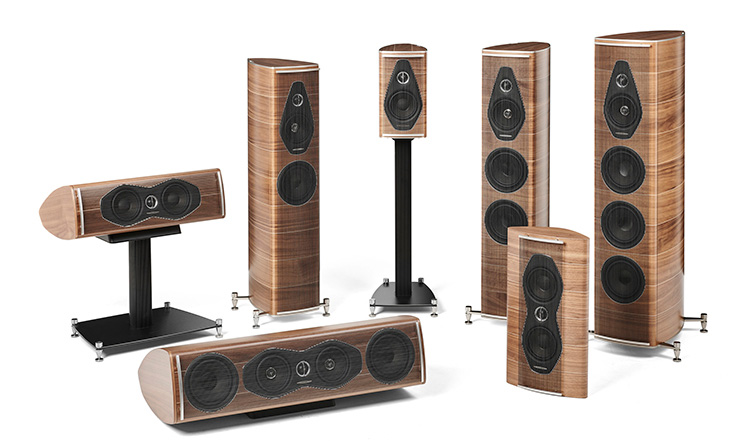
The Olympica Nova I is the smallest model in the new line comprised of seven speakers which I saw and heard firsthand at RMAF. The demo that I attended was impressive for an audio show, but the main speakers that most attendees got to sample at the event were the big towers, the Nova V. My Secrets colleague, Tyler Stripko has the Olympica Nova V in for review and his assessment should be published on our site by the time you read this. My past experience with Sonus faber has been that they have been very adept at getting big, attention-grabbing sound from relatively small speakers. So, I have a big room and I was curious to see what these exceedingly pretty 2-way speakers could do in a larger listening space. At $6,500.00 for the pair (not including bespoke stands) the Olympica Nova I are not a cheap date. Will they ultimately prove to be temperamental divas and buckle under the pressure of a big room or will they deliver a command performance befitting of their heritage? Read on for the details!
Description:
2-way Bass Reflex Bookshelf Loudspeaker with rear-firing slot port
High-Frequency Driver:
Single 1” silk soft-dome tweeter with DAD™ technology
Mid/Low-Frequency Driver:
Single 5.5” natural pulp fiber cone, fabric-coated dust cap
Frequency Response:
45Hz – 35kHz (Manufacturer)
Crossover Frequencies:
2500Hz
Nominal Impedance:
4 Ohms
Sensitivity:
87 dB (2.83 Volts @ 1 Meter)
Recommended Amplifier Power:
35 – 250 Watts
Available Finishes:
Satin Walnut and Wenge
Accessories:
Optional Aluminum stands ($1200.00/pair)
Dimensions (H x W x D):
14 x 7.8 x 15.5 inches (355 x 199.5 x 395mm) no stands
Net weight:
23.1 lbs (10.5 kg) each (no stands)
MSRP:
$6,500.00 (pair)
Company:
Company Directory:
SECRETS Tags:
sonusfaber, olympica, nova, speakers, bookshelf, Sonus Faber, Bookshelf Review 2020
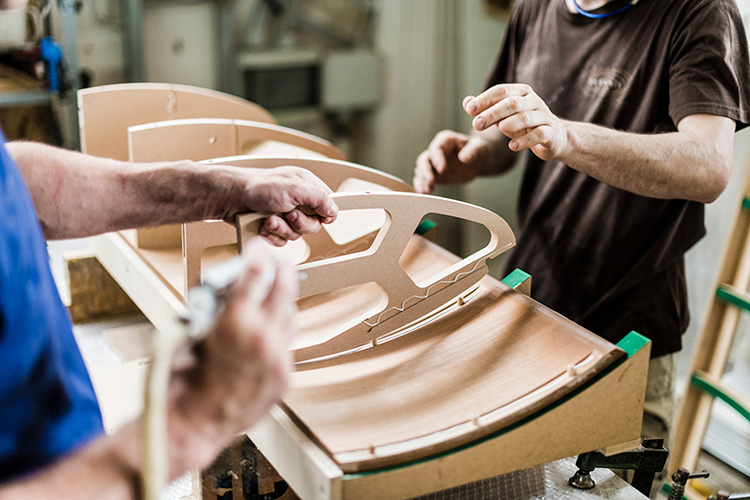
The Sonus faber Olympica Nova I are a two-way, rear-ported, stand-mounted monitor. While this is a technically accurate description of what they are, it doesn’t really begin to do them justice, at least not on an aesthetic level. Beginning with the enclosure, it’s not made of traditional MDF that is sheathed with a veneer. The sidewalls are constructed of 8 alternating layers of birch wood and HDF (high-density fiberboard) bonded together and pressed to obtain that curved shape. The front baffle is solid wood while the top and bottom “caps” of the speakers are cast aluminum plates with recessed areas for the veneer. Unlike most ported speakers that feature a flared tube for venting, the Nova I use a slot port that runs the vertical length of the enclosure’s spine. The entire spine itself is also cast from aluminum and is an integral part of the slot vent. It is textured and multi-vaned to help direct and control the air turbulence exiting the back. All these sections when combined, along with some internal HDF braces, results in an extremely rigid chassis that doesn’t yield any hollow sound when subjected to the knuckle-rap test. The whole shebang is sheathed in a beautiful and tasteful looking rich satin-walnut veneer with three lighter colored pinstripes running along the length of each side with two more along the top length.
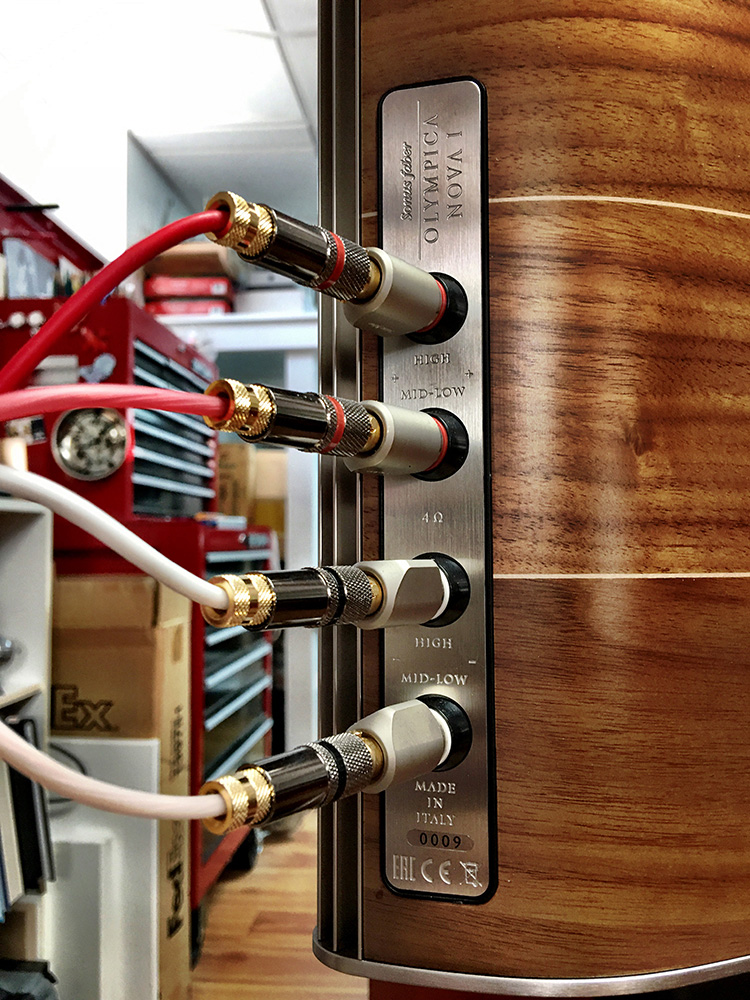
The four binding posts, vertically oriented by the rear spine of each speaker, are some of the nicest I’ve seen. Each is shaped with an integrated (and monogrammed) tab that makes them especially easy to grip and torque. They have a wonderfully tactile quality to them and show an attention to detail that is inherent throughout the design of these speakers. It’s actually really quite difficult not to want to run your hands over the Olympica Nova I and just feel where the aluminum and wood meet. I think the physical connection is an integral part of the experience when you own something so pretty and so well put together. It’s that “Italian” thing again.
The speaker grilles are also unusual in that they are not the typical sheer-cloth-stretched-over-a-frame affair. Instead, they are comprised of over 50 individual elastic cords stretched between two aluminum saddles. When in place, the look is meant to evoke thoughts of stringed instruments. Usually, I will eschew using speaker grilles because I prefer the look of loudspeakers when the drivers are visible. But in this instance, they stayed on. For once, I saw speaker grilles as an enhancement to the whole design as opposed to being an afterthought.
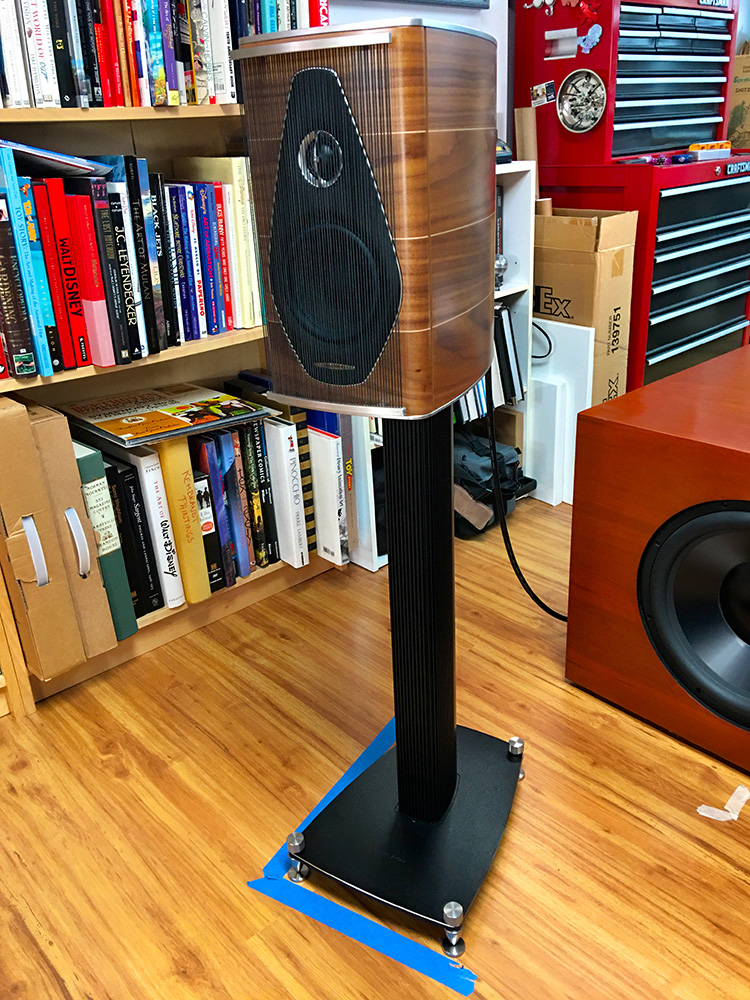
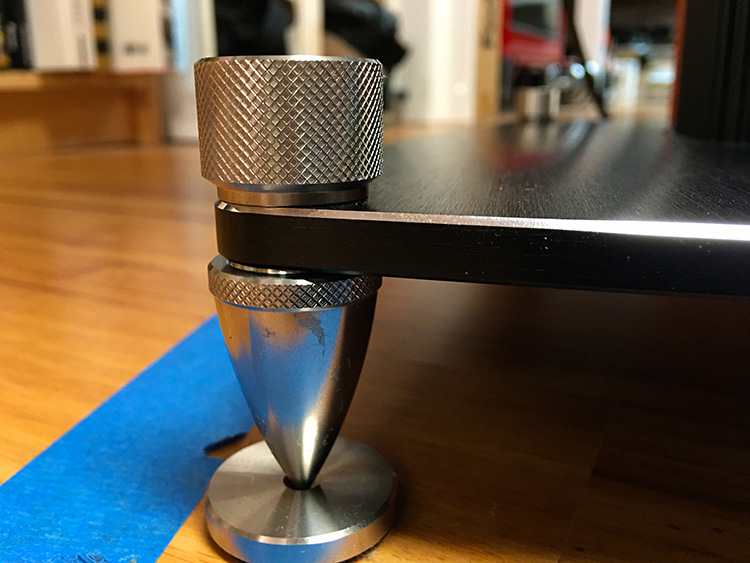
The Olympica Nova I were shipped to me with the optional bespoke stands. Made of black anodized aluminum, they are 28-inches tall and have an open channel in the rear to help conceal speaker wire. Each stand has four large bullet spikes that thread through the bottom plate and are secured with a large knurled cap. Aluminum disks with felt on the bottoms are included for when the Novas are situated on hard flooring. The speakers themselves are secured to the top plate of the stands via two knurled bolts each. It’s all rather simple, elegant and well thought out.
Turning our attention to the drivers, Sonus faber uses a custom 1-inch silk dome tweeter over which sits an interesting sort of Steampunk-like flange. This is part of what Sonus faber calls the DAD™ (Damped Apex Dome) system. As I understand it, a little nub underneath the midpoint of the flange gently tamps down on the apex of the tweeter diaphragm during its travel in order to suppress distortion and phase errors that naturally occur mostly at that location on the dome. Sonus faber claims that this allows an extended and precise on-axis response combined with smooth off-axis behavior and a wider soundstage. The 5.5-inch pulp fiber mid-woofer has a cone made of a variety of air-dried natural fibers, a fabric dust cap, and a special voice coil tuned for longer throw and extended bass response. Both these drivers are mounted together on the front baffle within a teardrop-shaped aluminum sub-assembly that is covered in natural leather. The crossover point between the two drivers is 2500Hz with the low-pass to the woofer being an electrical 1st-order slope and the high-pass to the tweeter being an electrical 4th-order slope.
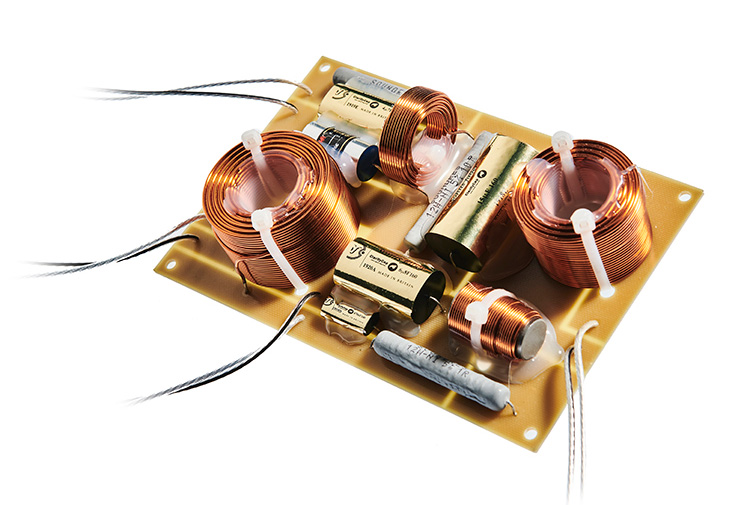
During the Olympica Nova launch at RMAF I spoke with Sonus faber’s Chief of Acoustic R&D Paolo Tezzon about the new line and some of the goals his team had in mind. A video of our conversation can be found here.
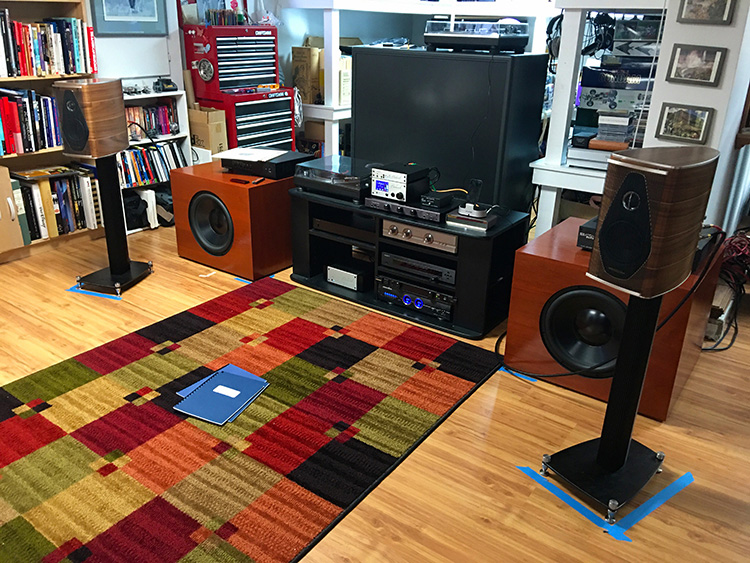
When the Olympica Nova I speakers arrived, I set them up in my studio listening area positioned about 9-feet apart on their stands and toed-in at about a 10-degree angle, as this is how I customarily start off. My seating position was also just under 9-feet away from either speaker. After some experimentation, I elected to leave them precisely in that position for the remainder of the review. An OPPO BDP-105D Universal Player served as a main audio source along with an ELAC Discovery Music server using ROON to manage my music files. Control components alternated between a NAD C658 streaming DAC used with my Class D Audio SDA-470C power amp and a full Benchmark Media systems front end. For a vinyl source, I used my Technics SL1200 Mk 6 modified by KAB Electroacoustic, along with an Audio Technica OC9ML/II Moving Coil phono cartridge. This was hooked up to the Pass Labs XP-25 Phono preamp. Speaker and interconnect cables were from Blue Jeans Cables.
I wasn’t entirely sure about what to expect from the Nova I when they arrived at my humble abode. At one end of the spectrum, I had heard the big Olympica Nova V towers at this past RMAF and got an inkling of what their capabilities were in a good-sized room. On the other end I had also heard the much more diminutive, but no less impressive, Electa Amitor III at an earlier RMAF so I knew what sort of acoustical voodoo the folks at Sonus faber could work with small boxes too. But here, I was looking to task a pair of moderately small 2-way ported monitors to fill a large basement studio space with sound while being placed well into the room. That is a big ask.
It seems I honestly needn’t have worried. Once I had the Nova I dialed into their final positions and pressed play on the remote control, they proceeded to just light up the room! These little Italian beauties produced an unexpectedly big and spacious sound that belied their size. With almost everything I played on them, the soundstage they painted went well beyond the physical speaker boundaries, both from side-to-side and front-to-back. The overall character to the speaker’s voicing was lush and rich sounding with a treble that sparkled but didn’t get fatiguing after lengthy bouts of listening. When sitting in the sweet-spot, the Nova I really nailed that “alive” quality that so appeals to me in certain speakers and, as slightly over-the-top as this next statement is going to sound, it seemed less like these speakers were playing and more like they were breathing.
Useful bass response got down to about 50 Hz in my room, keeping in mind the speakers were well away from the walls depriving them of additional low-end reinforcement. That being said, I didn’t find myself pining for a subwoofer either. The bass that the Olympica Nova I did put out was tuneful, punchy and in great abundance. The midrange, especially the vocal region, had a great sense of presence and body to it. Both male and female voices that were reproduced by these speakers came through with a slightly darker quality than some of the previous speakers that I’d just reviewed. But that’s only part of it, voices with the Sonus faber Olympica Nova I had a weight and tangibility to them that just amped up that alive quality that I previously mentioned. It was a little spooky, truth be told.
Beyond the way that the Nova I sounded when I was sitting in their crosshairs, it is how they performed when I wasn’t that was equally as impressive. They still sounded so big and so dimensional when I was sitting far afield at my workstation or drawing desk. And off-axis that sparkling treble became smoother, but it didn’t seem to dull the sense of detail in what I was listening to. It was still lively enough to keep my attention and involvement in the music. Getting any productive work done with these speakers around proved to be a challenge and the design team at Sonus faber should take that as one of the higher compliments that I could give.
If you’ll permit me, I’m going to indulge in a more personal comparison next. These speakers remind me very much of this one Italian girl that my cousin dated many years ago. It was during a family trip to Sicily and I’ve long since forgotten her name. I remember her though as being eminently pretty and very refined yet still also very down to earth. But the thing that struck me the most about her wasn’t so much her looks or her demeanor but her voice. It was equal parts soothing and bewitching. I remember as a teenage male thinking to myself that, I could close my eyes and this girl could read me the ingredients off a cereal box and I’d just be done for. It’s my first concrete memory of a sound that was unintentionally yet unambiguously seductive – a siren call if you will. That’s what these speakers represent to me. Wood, paper, rubber, copper, aluminum, blood, sweat and more than a few cups of espresso – all of it worked into a beautiful form that creates an almost irrationally seductive sound. Very impressive and yes, very Italian!

Nonesuch Records, CD, 1998.
Staying in the Italian vein for a moment, Paolo Conte has always struck me as Italy’s version of Tom Waites in his more classic piano playing raconteur persona. But he’s really so much more.
A sort of chain-smoking, raspy-voiced, hard-boiled musical detective, dutifully tickling the ivories and spinning yarns in this collection of career-spanning tracks. Cueing up the song “Sparring Partner” reveals a spacious sounding piano intro with a lovely ring and density to the notes. This is accompanied with a strumming acoustic guitar in the right channel that has just the right detailed crispness to its strings. Conte’s raspy voice comes in after the intro and the Nova I peg it perfectly centered, floating right between the speakers. There is a lot of character and expression in that Mediterranean haggard voice and the little Sonus fabers revealed every bit of nuance that it had. The detailed sound of the bongo drums in the left channel was a surprise to me as they are normally more obscured by other sounds when I’ve listened to this track in the past. The Nova I rendered them more clearly and with more dimension than what I’ve heard before. “Happy Feet” has Conte providing a great almost boogie-woogie style piano performance that sounds so big and resonant that it seems hard to fathom it coming solely from these two little stand mounts. “Gli Impermeabili” has a nice punchy sounding kick drum that anchors much of the song and the Olympica Nova I give it plenty of weight and charge to its sound. Sure, it would hit harder if one took the time to blend a subwoofer into the mix, but the tonality of the speakers along with their sufficient reach made that kick drum sound suitably satisfying. Contrasting the kick drum in this song is a frantically playing triangle in the left channel. The Nova I gave that instrument just the right amount of sparkle and sheen while throwing its image out well beyond the left speaker boundary. It floated, almost holographically, to my immediate left. These speakers imbued such a great character to this music I was listening to that they even made the kazoo played at the exit of this song sound like a noble instrument! Outstanding!
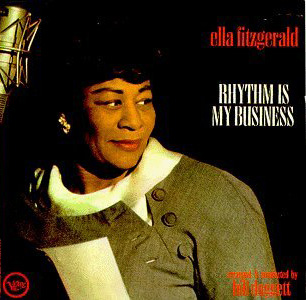
Verve LP, V6-4056, 1962
Switching things up with a little classic vinyl, Ella Fitzgerald’s voice is in top form on this classic album where she is backed by a big band and an organ. “Hallelujah I love Him So” starts with an almost reverent sounding organ intro and then that big brassy band jumps in followed by Ella’s vocals.
The whole song is big and lush sounding with the Nova I extending the sound of the band fairly wide and deep with Ella’s vocals placed firmly in the center of the stage. One might worry that the Nova’s attention-getting DAD tweeter assemblage could portend some really hot sounding brass but that wasn’t the case here. All the instrumentation sounded quite lush with just the right amount of brightness coming from the horns. “I Can’t Face the Music (Without Singing the Blues)” is a slower-paced number but no less effective a vehicle for showcasing Fitzgerald’s powerful vocal range. I have this album both on vinyl and digital and her voice on the vinyl had far more body and depth for the little Sonus fabers to exploit than did the CD. And shine her voice did on this track, sounding clear, potent and focused throughout. The Nova I also did nice work with the double bass on this song imbuing the bass line with a nice weight to it. The saxophone solo midway through the track was also a standout, sounding clean, melodic and unfatiguing.

Jazz Village Records, Qobuz 24/96 FLAC via ROON, 2016.
I stumbled upon this recording as a recommendation from ROON based on what it determined my listening preferences to be. Such a crafty piece of software, it guessed correctly with this choice as I did enjoy this recording tremendously.
Almost entirely consisting of solo piano, the Olympica Nova I continued their party trick of making well-recorded music with plenty of ambiance sound positively huge on playback. The Nova I rendered Ahmad Jamal’s piano playing throughout this album with a rich and vibrant tone. The ring and decay of the individual notes sounded fantastic and the lower register notes had plenty of weight and texture to their sound. The instrument sounded like it was very much in the room with me. On the track “So Rare” Jamal is joined by James Cammack on double bass and the speakers just sail at painting a big rich picture of sparkling piano work buoyed by deep, thick acoustic bass lines. This is afternoon cappuccino-break music at its finest!

RCA, Qobuz 24/96 FLAC via ROON, 2019.
Thank my son Peter for introducing me to this one. The only Tool album I’ve ever heard and it’s a cracker. So how would these two little stand-mounted monitors handle a heavy metal/hard rock album? Incredibly well it seems!
No wimpy anemic performance here, the Olympica Nova I would be having none of that thank you very much. Peter and I sat through the whole Fear Inoculum album, cranked to a solid volume and while I thoroughly enjoyed what I was hearing, when I looked over at Peter, he was just grinning ear-to-ear. “Dad, these little things just crushed it!” was his summative statement and he was absolutely right. Right from the title track, the Nova I extended the music well beyond the boundaries of what seemed rational for speakers of their size and driver complement. The drum work on “Fear Inoculum”, “Chocolate Chip Trip” and “Invincible” had so much tactile depth and power to it and the Nova I just dished it out without a whimper or any sense of dynamic compression. Feeling that sort of impact in a room this size from speakers that small is nigh on amazing. Maynard James Keenan’s vocals always seemed perfectly clear and detailed with good body and dimension to them. The distorted and layered guitars had that thick crunchy edge to their sound that made it seem like they were in the room with us and the electric bass lines, particularly on “Invincible” were deep, impactful and stood out well.
Bench tests were performed with a Cross Spectrum Labs calibrated Earthworks M30 microphone connected to my workstation, via a Lynx 2B professional soundcard, and using Room EQ Wizard acoustic measurement software. On and off-axis measurements were taken with the mic at a distance of 1-meter from the tweeter. Unlike measurements taken outdoors or in an anechoic chamber that measure a speaker in isolation (and assess straight-line engineering), in-room measurements give a sense of how a speaker behaves in the actual environment that it’s used. Both types of measurements are valuable, I just find in-room measurements more interesting as they help shed light on what I am hearing and why.

This in-room measurement is an 18-point spatial average. A 9-point measurement was made for the right speaker and then repeated for the left speaker. Averaging both speakers is an approach others have been using and publishing. Using data from both speakers reduces the modal response of the room by averaging the differences in the response of the two speakers from room asymmetries. The technique cannot eliminate them however and, as such, the response below 300Hz remains room dominated. The results show a fairly uniform response from 250 Hz on up, exhibiting somewhat of a mild “smiley-face” curve past 800 Hz. The peak at 400 Hz seems to be an artifact of the room as it is showing up regularly in my measurements along with the dips at 160 Hz and 220 Hz. Bass response is solid down to about 55 Hz before rolling off. Treble response seems to gradually increase past 5 kHz. Subjectively, you would think that this would make these speakers overly bright sounding, but I didn’t get that impression. They were brighter than some other speakers I’ve heard but not objectionably so.
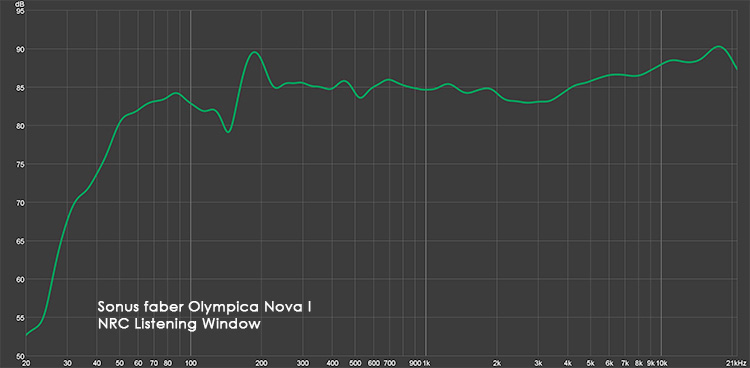
This is a plot of the NRC listening window which is averaged from the following measurements: 0-degree on-axis, +-15 vertical, +-15 horizontal, and +-30 horizontal. Here we see a nicely controlled response from 250 Hz to 2 kHz, followed by a dip between 2 kHz to 4kHz with an inclining treble response thereafter.
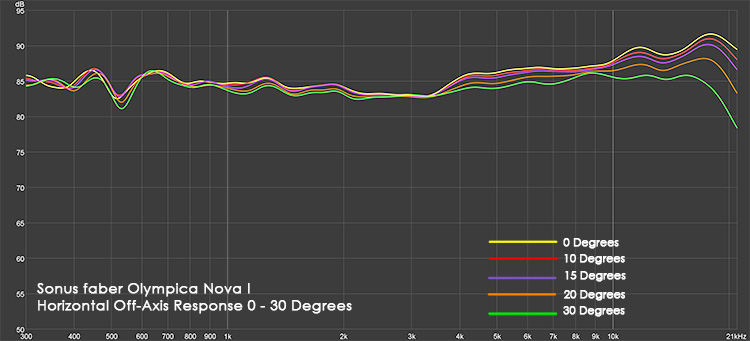
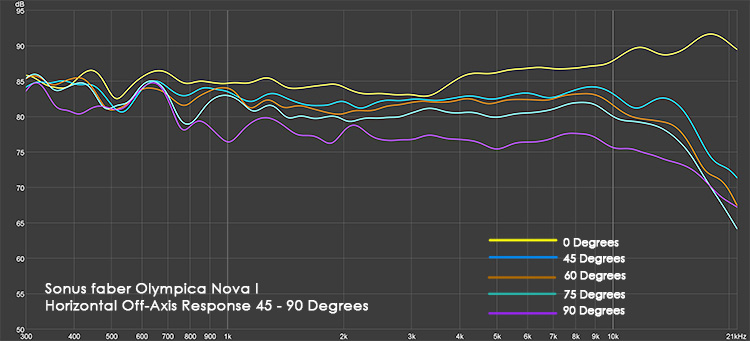
Above are the horizontal radiation curves of the Nova I from 0 to 30 degrees and 45 to 90 degrees, scaled from 300 Hz on up for the sake of detail. Looking at these plots in isolation, one can tell that the Nova I tweeter does not use a waveguide since as the woofer gets more directional with angle increase and then the curves snapping back at the crossover. It is not clear why things converge at 9 kHz before moving out again.
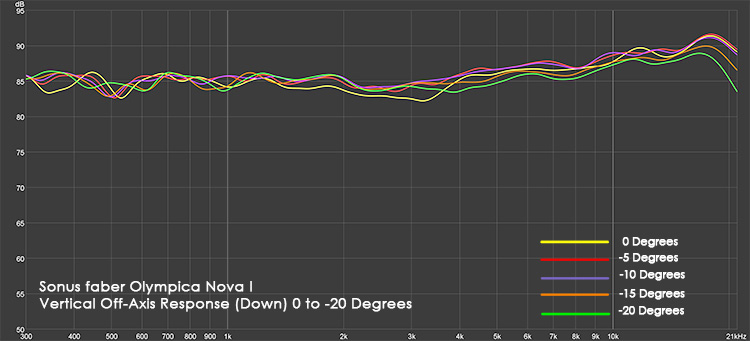
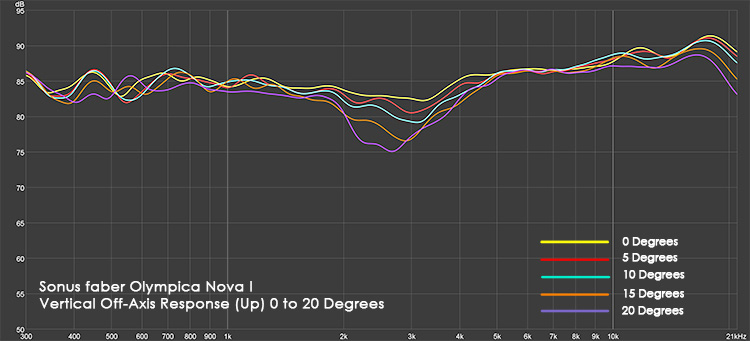
Moving to the vertical radiation pattern for positive and negative angles, we see the plots for 0 to -20 degrees and 0 to +20 degrees. The first image shows some of the midrange hole (from the horizontals) filling in and the tweeter boost decreasing as the mic moves down. The Nova I could comfortably be placed on taller stands without much of a change in this response. In the second image, coming up from the tweeter axis, we see energy loss growing quickly in the crossover region (2.5 kHz).
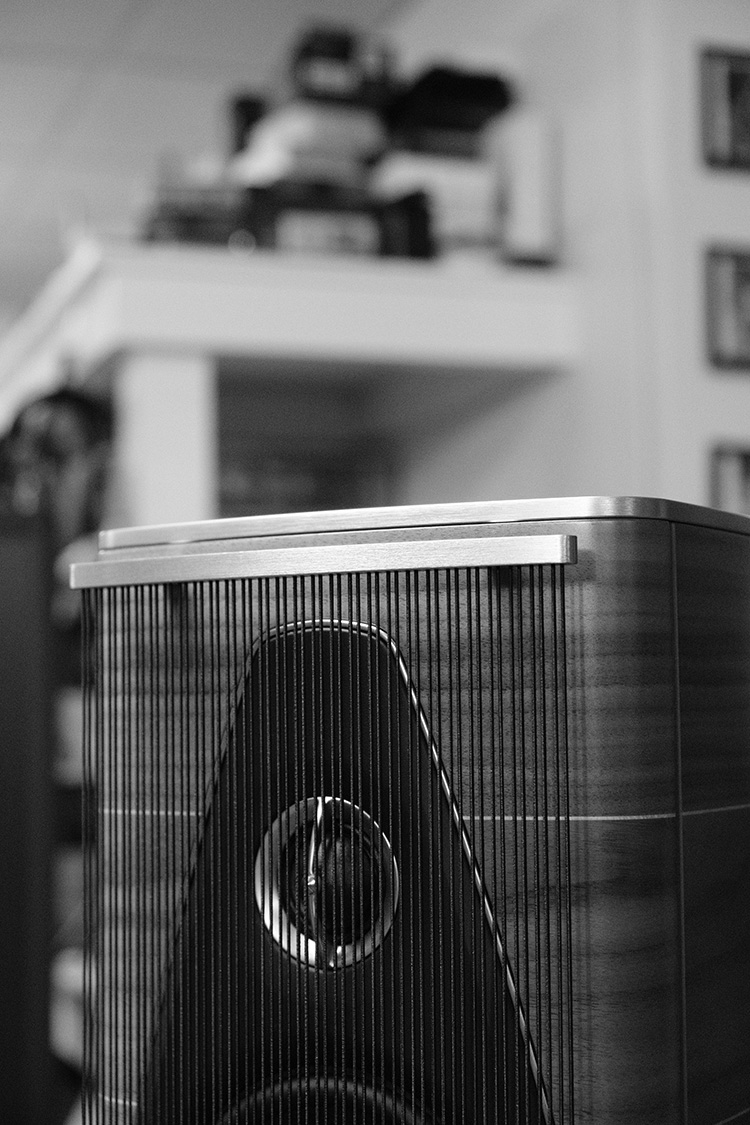
Make no mistake, the SONUS FABER OLYMPICA NOVA I sound as gorgeous as they look.
- Beautiful and unique Italian design.
- Rich, alive sound quality.
- Big soundstage and great tonality.
- Satisfying bass for their size.
- Nothing else to speak of.
In the final analysis, I freely admit to waxing a little more rhapsodic than usual with the Sonus faber Olympica Nova I. Honestly, I think it’s because they appeal to me on a few different levels, as both an audio reviewer and as a professional artist. They certainly exceeded my expectations in terms of how I thought they would perform in my large studio space/listening area. They put out a sonic image bigger and sweeter sounding than they really had any right to. Their overall voicing character was immensely appealing, remaining enjoyable when listening both on and off-axis. Perceived upper-end detail was doled out in abundance without sounding oppressive, and bass response was surprisingly satisfying given how I set them up in the room. All that would be impressive enough for a typical box speaker, but in this case, the design of the Nova I adds a whole other dimension of value to my eyes. Its overall aesthetics, the beauty of its sculptural form, the materials used and the attention to detail in the overall execution elevates them to a higher level of artwork. This is acoustic alchemy in the truest sense. I’d also be lying if I said my Italian heritage didn’t bias me towards these speakers in one degree or another. But rest assured, if the Sonus faber Olympica Nova I sounded like an old FIAT I would have told you so. Far from it. I was genuinely saddened when I had to relinquish these little beauties to the McIntosh Group mothership. Some people might say that you should have your head examined for considering spending $6500.00 for a pair of bookshelf speakers plus another $1200.00 for the custom stands. And perhaps they’re right. But I would urge you, if you are so inclined, to seek these speakers out at a dealer or audio show and both look and listen to them. Feel the finish of them. See if you don’t get an inkling of what I’m talking about. At the end of the day, if you just want a nice sounding pair of boxes for your listening room, then these aren’t the speakers for you. If, on the other hand, you are looking for something that is a little more special, something that is less of a commodity item, then I’m quite certain Sonus faber would tell you to come on in, the water is fine!
The author would like to thank David A. Rich for his assistance in this review.


